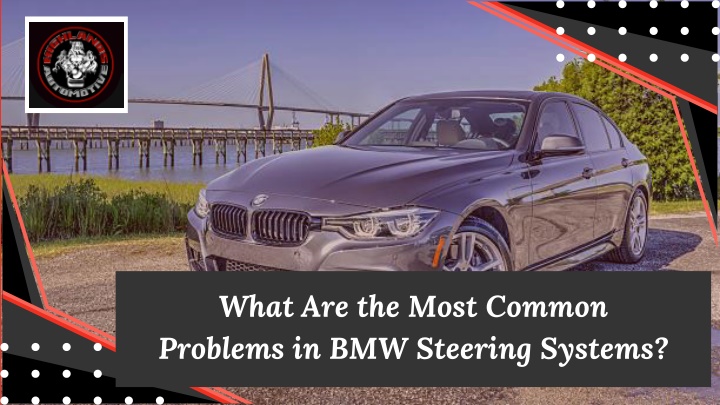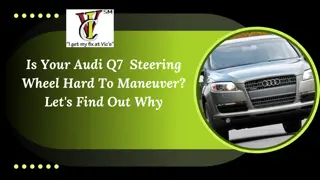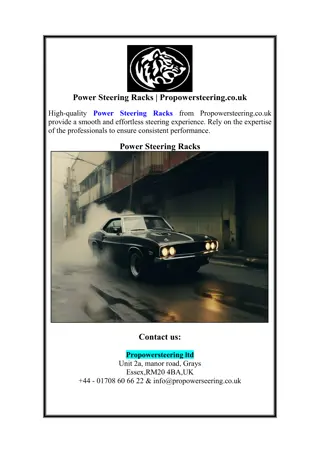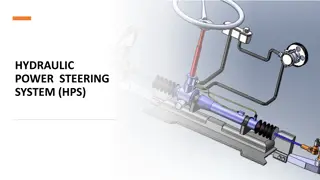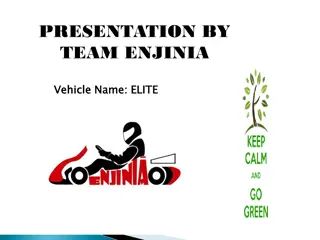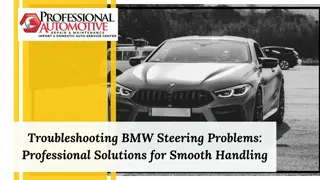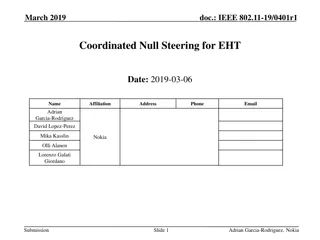What Are the Most Common Problems in BMW Steering Systems
BMW steering systems can experience common issues such as power steering fluid leaks, faulty steering racks, and worn suspension components. Symptoms include difficulty turning, unusual noises, or a vibrating steering wheel. Prompt diagnosis and prof
Download Presentation

Please find below an Image/Link to download the presentation.
The content on the website is provided AS IS for your information and personal use only. It may not be sold, licensed, or shared on other websites without obtaining consent from the author.If you encounter any issues during the download, it is possible that the publisher has removed the file from their server.
You are allowed to download the files provided on this website for personal or commercial use, subject to the condition that they are used lawfully. All files are the property of their respective owners.
The content on the website is provided AS IS for your information and personal use only. It may not be sold, licensed, or shared on other websites without obtaining consent from the author.
E N D
Presentation Transcript
What Are the Most Common Problems in BMW Steering Systems?
Steering Wheel Vibration: This issue can manifest as a shaking or trembling sensation in the steering wheel, often noticeable at specific speeds.
Power Steering Fluid Leaks: Leaks in the power steering system can lead to reduced power assistance, making steering difficult, especially at low speeds.
Steering Rack Issues: Problems with the steering rack, a crucial component in the steering system, can result in imprecise steering, excessive play, or difficulty turning the wheel.
1 . STEERING WHEEL VIBRATION
Wheel Imbalance: Uneven weight distribution in the wheels can cause vibrations, especially at higher speeds.
Worn Tires: Bald or unevenly worn tires can lead to vibrations, particularly when driving on rough roads.
Bent Wheel Rims: Damaged rims can cause the tires to wobble, resulting in steering wheel vibrations.
2 . POWER STEERING FLUID LEAKS
CAUSES: WORN OR DAMAGED LEAKY POWER HOSES STEERING PUMP
REDUCED POWER STEERING ASSISTANCE DIFFICULTY TURNING THE STEERING WHEEL, ESPECIALLY AT LOW SPEEDS SYMPTOMS: FLUID STAINS UNDER THE CAR
Worn Steering Rack Bushings: These bushings, responsible for absorbing shock and vibration, can wear out, leading to a loose steering feel and noise.
Damaged Steering Rack Boots: The boots protect the internal components of the steering rack from dirt and debris. Damage to the boots can allow contaminants to enter, causing premature wear.
Internal Mechanical Failure: Over time, the internal components of the steering rack, such as gears and bearings, can wear out or become damaged, resulting in a loss of steering precision and increased effort.
4. ELECTRIC POWER STEERING (EPS) MALFUNCTION
CAUSES: FAULTY EPS CONTROL MODULE DAMAGED EPS MOTOR ELECTRICAL WIRING ISSUES
SUDDEN LOSS OF POWER STEERING ASSISTANCE STEERING WHEEL BECOMING HEAVY AND DIFFICULT TO TURN SYMPTOMS: WARNING LIGHTS ON THE DASHBOARD
Worn Tie Rod Ends: These components connect the steering rack to the wheels. Worn tie rod ends can cause loose steering, uneven tire wear, and vehicle pulling to one side.
Damaged Tie Rod Boots: The boots protect the tie rod ends from dirt and debris. Damaged boots can allow contaminants to enter, accelerating wear and potentially leading to failure.
Loose or Stripped Threads: Loose or stripped threads on the tie rod end can cause excessive play in the steering, making it difficult to maintain control of the vehicle.
CAUSES: WORN OR DAMAGED CONTROL ARM BUSHINGS
EXCESSIVE TIRE WEAR SYMPTOMS: LOOSE STEERING FEEL Clunking noises from the front suspension
Early detection and timely repair of steering system issues are crucial for maintaining vehicle safety and performance.
Regular vehicle inspections, including tire rotations and wheel alignments, can help identify potential problems early on.
If you experience any symptoms of steering system problems, it's important to consult a qualified mechanic for diagnosis and repair.
https://www.highlandsautomotive.com/ https://www.facebook.com/HighlandsAutoservice THANK YOU
